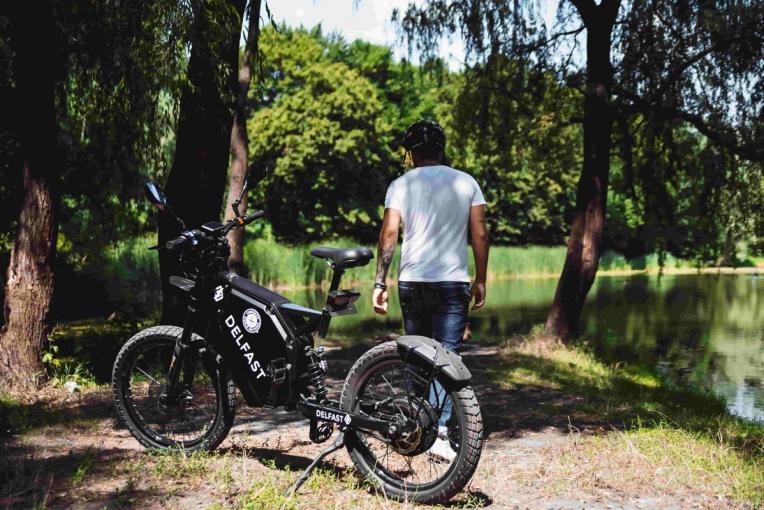
Green areas in any city deserve special attention not just because of the outstanding urban design but also for them being a soothing, freshly spot in the middle of a megapolis. You cannot forget a trip to one of the many national parks scattered all over the US. And what better way to explore the national parks than riding a Delfast TOP 3.0? This electric bicycle opens the possibility to travel through challenging outdoor terrain with less effort for the rider. The TOP 3.0 has been upgraded recently. Now it features a powerful 3,000W motor and a high-capacity 72V/48Ah battery. This system enables a maximum range of 200 miles, which is more than enough for an entire day of cycling in the countryside.
The TOP 3.0 is equipped with motocross tires, which allows for better grip. Moreover, the TOP 3.0 is equipped with pedal-assist riding modes that comply with speed regulations in America. It also includes a throttle mode, which can be used in extreme situations like climbing a hill. This versatility provides unmatched comfort and safety while riding in the great outdoors.
On December 2, 2020, the National Park Service (NPS) began enforcing a new regulation that allows the use of electric bikes where conventional pedal bikes can ride. This regulation accommodates the growing number of e-bikes for recreational purposes in America. With this regulation, more people will be able to enjoy nature in all the territories administered by the NPS. At the same time, the regulation will ensure that natural resources remain protected.
The regulation exempts electric bicycles from the definition of motor vehicles. Instead, it adopts the three-class system to define e-bikes. Superintendents in every national park can decide what class of ebike is allowed in each trail. They retain the right to impose conditions on the use of electric bikes to guarantee visitors’ safety and protection of natural resources. The use of conventional and electric bikes in wilderness areas is prohibited.
Therefore, to comply with regulations, always check with the park administration all the details on the use of electric bikes. Make sure your e-bike is allowed on the trails you intend to ride to avoid fines or other penalties. Bear in mind that the regulation allows the use of electric bikes in pedal-assist mode only. The use of the throttle mode for an extended period is prohibited.
Also, the corresponding state laws apply for the use of e-bikes in national parks. You should check the laws of the state where the park you intend to visit is located. Licensing, helmet usage, and age requirements are different in every state. Make sure you comply with state laws first. The NPS has an online trip planning guide that will help you have a smooth cycling trip. Also, almost all national parks provide guides with information about the most scenic cycling routes. Ask the park administration about such guides.
Riding your electric bike in a national park will pose some challenges. You can expect uneven terrain and, in the rain season, mud and water pools will be part of the trail. Riding uphill and downhill won’t be uncommon either. The Delfast TOP 3.0 shines in these conditions. Its sturdy construction and powerful electric system will help you to conquer even the most challenging terrain. In this way, you can focus on sightseeing and enjoying the surrounding nature.
Also, you should take some safety measures to avoid an accident along the route. But don’t be discouraged. By applying the following tips, you’ll have a pleasant and safe ride:
The National Park System in the United States offers great opportunities to enjoy nature on your electric bike. With the proper safety measures, each ride will be an unforgettable experience. For more great routes and tips for safe riding in America and other parts of the world, please subscribe to the Delfast newsletter.